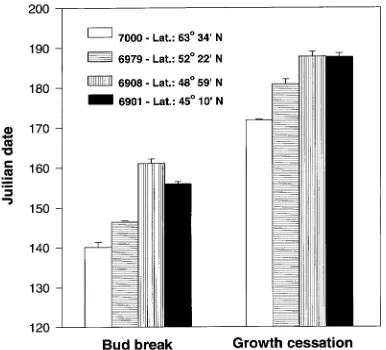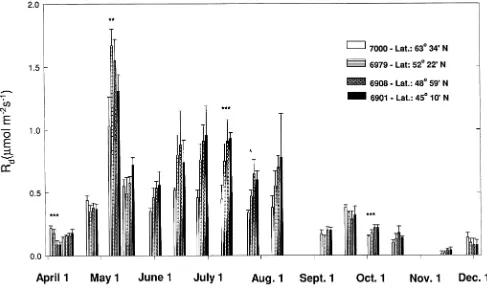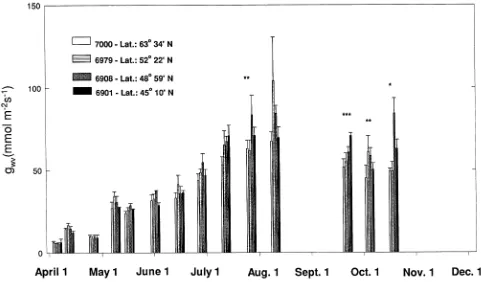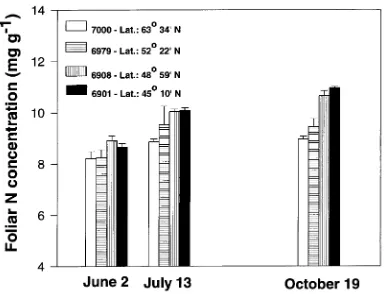Summary Four sources of 23-year-old black spruce (Picea mariana (Mill.) B.S.P.) from a provenance test at the Petawawa National Forestry Institute (46° N, 77°30′ W) were assessed for height growth, shoot phenology and seasonal gas exchange. The provenances were designated 7000 (Yukon, 63°34′ N, 135°55′ W), 6979 (Alberta 52°22′ N, 115°15′ W), 6908 (On-tario, 48°59′ N, 80°38′ W) and 6901 (Ontario, 45°10′ N, 77°10′ W).
Trees of southern provenances (6901 and 6908) were con-siderably taller, and broke bud and ceased growth later than trees of northern provenances (6979 and 7000). In early spring, trees of northern provenances had higher net photosynthetic rates (Pn) than trees of southern provenances (6908 and 6901). During midsummer, trees of Provenance 7000 generally had the highest Pn as a result of low rates of shoot dark respiration (Rd). Trees of northern provenances displayed an earlier autumn decline in Pn than trees of southern provenances. Provenance differences in growth, shoot phenology and physi-ology agreed well with results from a greenhouse study of seedlings from the same provenances. We conclude that the poor growth performance of trees of northern provenances in Ontario was associated with: (1) a short period of shoot growth, (2) a high rate of dry matter partitioning to roots, (3) low rates of late-season Pn in response to decreasing photope-riod, and possibly, (4) a high rate of root Rd.
Keywords: gas exchange, genetic variation, mature tree, pho-toperiod, Picea mariana, provenance.
Introduction
Studies on genetic variation in responses to environmental factors are often limited to greenhouse or controlled environ-ment experienviron-ments with seedlings, because of technological, spatial and temporal limitations (Bourdeau 1963, Sorensen and Ferrell 1973, Bilan et al. 1977, Boltz et al. 1986, Bongarten and Teskey 1986, Oleksyn et al. 1992). However, few com-parative studies have been undertaken to determine whether genetic responses of seedlings under controlled conditions are indicative of the performance of trees in the field.
In a companion paper (Johnsen and Seiler 1996), we re-ported a greenhouse experiment on growth, phenological and physiological responses of seedlings of diverse sources of
black spruce (Picea mariana (Mill.) B.S.P.) to varied atmos-pheric CO2 and photoperiod treatments. Here, we report the results of a concurrent study that examined growth and sea-sonal patterns of phenology and physiology of 23-year-old black spruce trees from the same sources of black spruce as used for the seedling study. Our purpose was to assess whether provenance behavior of greenhouse-grown seedlings approxi-mated that of field-grown trees. In addition, phenological and physiological results from both studies were used to identify adaptive mechanisms of black spruce and to assess their con-tribution to growth performance in a common garden experi-ment.
Materials and methods
The black spruce trees were located in a provenance test planted as 4-year-old stock at the Petawawa National Forestry Institute (46° N, 77°30′ W) in 1974 (Morgenstern 1978, Boyle 1985). The four provenances selected were: 7000 (Yukon, 63°34′ N, 135°55′ W), 6979 (Alberta, 52°22′ N, 115°15′ W), 6908 (Ontario, 48°59′ N, 80°38′ W) and 6901 (Ontario, 45°10′ N, 77°10′ W). The plantation was established as a randomized complete block design with 16-tree plots (4 × 4) planted at 1.8-m spacing in each of three blocks. Provenance 7000 plots were originally established only in Blocks 1 and 2. In 1993, the percentage of surviving trees was 90% for Provenance 6901, 96% for Provenance 6908, 96% for Provenance 6979, and 56% for Provenance 7000.
All trees were measured for height growth in the autumn of 1992. In spring 1993, four trees per provenance per block (i.e., 12 trees per provenance) were randomly selected for phenol-ogy measurements. For Provenance 7000, eight trees were measured from Block 1 because that source was not planted in Block 3. Three branches were selected from the midcanopy on the south-facing side of each selected tree. A mark was made at the base of the terminal bud on each branch. Beginning May 3, 1993, branches were assessed for bud break (defined to occur when needles emerged from among the bud scales). After bud break, new shoot lengths were measured until July 20 when shoot elongation terminated. The date of growth cessation was estimated as the date when 95% of final shoot length was achieved.
Growth, shoot phenology and physiology of diverse seed sources of
black spruce: II. 23-year-old field trees
KURT H. JOHNSEN,
1JOHN R. SEILER
2and JOHN E. MAJOR
1 1Canadian Forest Service, P.O. Box 4000, Fredericton, NB E3B 5P7, Canada
2
Department of Forestry, Virginia Polytechnic Institute and State University, Blacksburg, VA 24061-0324, USA
Received January 18, 1995
Gas exchange was measured on 17 occasions from April 6 to December 1, 1993. Measurements were taken over four periods during each day: 0900--1000, 1030--1130, 1230--1330 and 1400--1500 h. During each measurement period, one tree was measured per provenance per field-block for a total of 12 trees measured per provenance per day. Because of the absence of Provenance 7000 in field-block three, two Provenance 7000 trees were measured in field-block one during each time-block. Measurement trees were selected randomly per plot. The same 12 trees per provenance were measured on all dates with one exception; because of the small size and lack of branches of one sample tree, a substitute Provenance 7000 tree was used for all measurements including and after September 8.
Gas exchange was measured on detached branches within 2 min of removing the shoot from the tree (Meng and Arp 1993, Johnsen and Major 1995). At the time of sampling, approximately 20-cm sections of branches were cut from the upper third of the crown that was exposed to maximum illumi-nation at that particular time. Shoots were immediately placed in a plastic bag containing moist paper towels. Gas exchange was measured on a 3-cm section of second-year foliage (ex-panded in 1992) with an LI-6200 portable photosynthesis system with a 250-ml chamber (Li-Cor Inc., Lincoln, NE). Measurements of net photosynthesis (Pn) and needle conduc-tance (gwv) were made in incandescent light (12 V, 75 W General Electric EYF lamp) that provided approximately 2200 µmol m−2 s−1 photosynthetic photon flux density. Following measurement in light, the chamber was covered for approxi-mately 90 s before measurement of dark respiration (Rd). Needles were removed to measure projected needle surface area with an LI-3100 leaf area meter (Li-Cor Inc.). The pro-jected surface area was multiplied by four to estimate total needle surface area. Needles were then dried at 65 °C to constant weight. Needles sampled on June 2, July 13 and October 19 were analyzed for total N concentration by stand-ard Kjeldahl techniques.
Data were evaluated by analysis of variance (ANOVA) using a randomized complete block design. Block means were used to conduct ANOVAs. For morphological traits and foliar N concentration, provenance means per field-block were used. For gas exchange traits, provenance means per time-block were used. Time-blocks were used for gas exchange traits because they were more effective in partitioning environ-mental (nonprovenance) variation than physical blocks. Net photosynthesis, Rd, gwv and foliar N concentration were ana-lyzed by date. Gas exchange was expressed on a needle surface area basis and a needle weight basis. Because of heavy dew, intermittent drizzle or the previous night’s rainfall, wet foliage resulted in gwv data being discarded for September 8, the morning of September 22 and the morning of October 19. On November 16 and December 1, a combination of low tempera-ture and high relative humidity resulted in unreliable gwv meas-urements, which were also discarded.
Results
The four provenances varied in average tree height (P =
0.0005): Provenance 7000 was 246 cm, Provenance 6979 was 469 cm, Provenance 6908 was 605 cm, and Provenance 6901 was 699 cm. Trees of the Yukon (7000) and Alberta (6979) provenances broke bud and ceased shoot growth earlier (P = 0.0001 for both traits) than trees of the Ontario (6901 and 6908) provenances (Figure 1).
Shoot gas exchange data expressed as a function of either needle surface area or needle dry weight were similar, and therefore, the shoot gas exchange results are presented only on a needle surface area basis. Although there was variation among provenances, shoot carbon exchange of all trees was low in the early spring, increased to a maximum in the summer, and declined in the fall (Figures 2 and 3). The high Rd on May 10 was caused by high air temperatures (Table 1).
On the first two sampling dates in April, with snow still on the ground, trees of the two northern (6979 and 7000) prove-nances had higher Pn than trees of the two southern (6901 and 6908) provenances (Figure 2). After the first two sampling dates, Provenance 7000 trees had the highest mean Pn until the August 11 measurement date (Figure 2), although this differ-ence was statistically significant only on July 13. On Septem-ber 22, trees of the two northern sources (7000 and 6979) had lower Pn than trees of the two southern sources (6901 and 6908) (Figure 2). Net photosynthetic rates of trees of the Yukon and Alberta provenances showed signs of decline in August and at the end of September, respectively, whereas trees of the two Ontario provenances maintained high Pn throughout Oc-tober.
Needle conductance generally increased from spring to summer (Figure 4) and then declined slightly during the autumn. Generally, provenance differences in gwv were smaller than those observed for the other gas exchange traits.
On all measurement dates, trees of the two northern prove-nances (6979 and 7000) had lower foliar N concentrations than
Figure 2. Seasonal progression of mean (± 1 SE) net photosynthesis (Pn) of four diverse sources of 23-year-old black spruce from a field provenance test located at the Petawawa National Forestry Institute. Each bar is a mean of four time-blocks with three trees per provenance per time-block. Statistical significance from ANOVA, by date, is indicated with asterisks: * = P≤ 0.1, ** = P≤ 0.05, and *** = P ≤ 0.01.
trees of the two southern provenances, although this trend was statistically significant (P = 0.0004) only on October 19 (Fig-ure 5). There was also a general trend for foliar N concentra-tions to increase over the season, with trees of the northern
provenances reaching maximum values by July 13 and trees of the southern provenances showing increases until October 19 (Figure 5).
Discussion
Provenance differences in growth, shoot phenology and physi-ology of the 23-year-old black spruce trees were similar to those observed in a greenhouse study of seedlings of the same provenances (Johnsen and Seiler 1996). The four provenances studied displayed strong clinal variation in height growth (cf. Morgenstern 1978, Boyle 1985). In addition to height growth differences, trees of northern provenances broke bud and ceased growth earlier than trees of southern provenances. These clinal responses are similar to those observed in other conifer species (Wright and Bull 1963, Mergen 1963, Johnsen et al. 1988, Oleksyn et al. 1992).
There was a strong correlation (r2 = 0.99) between mean provenance height of 23-year-old trees grown in the field and seedling height from a concurrent greenhouse study (Johnsen and Seiler 1996). However, Sulzer et al. (1993) found that, in a retrospective test with black spruce open-pollinated families from an operational tree improvement program, greenhouse-grown seedling height was only moderately correlated (r = 0.48) with 10-year field height.
Mature tree phenology was also qualitatively related to seedling performance. Bud break was earlier in northern Table 1. Cuvette temperature, relative humidity (RH) and vapor
pres-sure deficit (VPD), by date, from gas exchange meapres-surements in a black spruce provenance test (SD in parentheses).
Date Temperature (°C) RH (%) VPD (kPa)
April 6 16.92 (1.30) 20.06 (2.80) 1.81 (0.24) April 13 10.62 (2.51) 44.05 (5.86) 1.01 (0.33) April 27 19.12 (1.89) 14.60 (1.64) 2.76 (0.50) May 10 36.77 (3.15) 27.36 (5.27) 5.86 (1.31) May 18 23.44 (2.97) 28.87 (4.82) 2.46 (0.54) June 2 21.47 (3.29) 38.75 (6.00) 2.19 (0.72) June 16 23.55 (5.21) 40.39 (10.52) 2.67 (1.22) June 29 23.08 (1.82) 51.46 (5.54) 1.93 (0.37) July 13 26.75 (3.27) 45.21 (6.91) 2.01 (0.62) July 28 29.28 (1.96) 59.48 (5.22) 1.67 (0.39) August 11 27.37 (2.37) 69.66 (9.64) 1.15 (0.50) September 8 17.58 (1.56) 77.28 (5.30) 0.46 (0.15) September 22 24.05 (2.00) 35.61 (2.45) 1.94 (0.25) October 5 12.05 (2.35) 40.81 (12.01) 0.88 (0.28) October 19 11.91 (0.38) 45.73 (1.89) 0.76 (0.03) November 16 7.16 (1.67) 68.59 (8.81) 0.32 (0.12) December 1 −0.60 (1.89) 60.86 (5.83) 0.23 (0.06)
provenances in both field-grown trees and greenhouse-grown seedlings (Johnsen and Seiler 1996), but differences in the timing of bud break among the provenances were almost 2 weeks greater in the field-grown trees than in the green-house-grown seedlings. The consistently higher temperatures in the greenhouse may compress provenance differences if bud break is related to heat accumulation as has been observed with Douglas-fir (Pseudotsuga menziesii (Mirb.) Franco) (Camp-bell and Sugano 1979).
Growth cessation, rather than bud set, was evaluated in the field because buds were apparent on all shoots in the field within 2 weeks of bud break although shoot extension was continuing. Growth cessation of 23-year-old trees occurred earlier in northern provenances than in southern provenances. Patterns of bud set of seedlings in the greenhouse were similar to the patterns of growth cessation in the field-grown trees, although provenance differences in the greenhouse were much larger than in the field (Johnsen and Seiler 1996). The differ-ence in the date of shoot growth cessation between field-grown trees of the Yukon and Ontario provenances was only 16 days, whereas the difference in date of bud set in the greenhouse-grown seedlings was 50 to 60 days.
The greater provenance differences in bud set date in the greenhouse-grown seedlings relative to growth cessation date in the field-grown trees are related to the difference between seedlings and older trees in the capacity for free growth. Pollard and Logan (1974) determined that among 10 prove-nances of 4-year-old black spruce seedlings, representing a large range in growth rate, growth differences were strictly related to differences in free growth. The capacity for free growth disappears with age (Nienstaedt 1966, Jablanczy 1971): Pollard and Logan (1976) found that provenance differ-ences in shoot growth of 12-year-old black spruce trees were predominately a result of differences in fixed growth. Pollard (1973) observed that fast-growing provenances of 12-year-old white spruce (Picea glauca L.) continued initiation of primor-dia later into the autumn than slow-growing provenances. Thus
it appears that both black spruce seedlings and trees from more southern origins take advantage of longer growth seasons; seedlings do so largely by maintaining free growth for a longer period, and older trees do so by extending the period of primor-dium production.
There were also large differences among provenances in carbon exchange rates that appeared to reflect differences in seed source latitude. In the early spring, both northern prove-nances displayed higher rates of Pn than the southern prove-nances. Fryer and Ledig (1972) demonstrated that, in greenhouse-grown balsam fir (Abies balsamea (L.) Mill.) seedlings that had set bud, the temperature optimum for Pn decreased with the increasing elevation of the seed source. However, in our study, the northern provenances had lower Pn than the southern provenances under cold conditions in the autumn. Thus provenance differences in Pn in the spring cannot be explained simply by different Pn temperature optima but are probably related to variations in metabolic activity, as indi-cated by the higher shoot Rd and earlier bud break of the northern provenances compared to the southern provenances.
Trees of the Yukon provenance had the highest rates of Pn during late spring and summer as a result of low Rd, which may reflect the low shoot metabolic activity of the slow-growing trees of this provenance. In the greenhouse study, seedlings of the Yukon provenance also had higher Pn than seedlings of an Ontario provenance (Johnsen and Seiler 1996); however, in contrast to the field results, provenance differences in seedling Pn were not due to provenance differences in Rd. Also in contrast to the field-grown trees, the greenhouse-grown seed-lings of the Yukon provenance had a 19% greater mean foliar N concentration than seedlings of the Ontario provenance (Johnsen and Seiler 1996). The provenance differences in foliar N concentration of seedlings may be an experimental artifact resulting from a dilution effect reflecting the large differences in seedling size. The higher Pn of seedlings of the Yukon provenance relative to seedlings of the Ontario prove-nance may be associated with the proveprove-nance differences in foliar N concentration.
Trees of northern provenances also displayed earlier de-clines in carbon exchange rate in autumn than trees of southern provenances. Similar results have been reported for jack pine (Pinus banksiana Lamb.) (Logan 1971), balsam fir and red spruce (Picea rubens Sarg.) (Gage and Dehayes 1992). The initial decline in Pn in autumn appears to be mediated by photoperiod because, in the greenhouse study, seedlings of the same Yukon provenance (7000) maintained high Pn in Septem-ber in an extended photoperiod treatment, but not in a natural photoperiod treatment (Johnsen and Seiler 1996).
Because southern provenances were probably initiating needle primordia more actively in the late season than northern provenances, late-season Pn rates may be related to bud activ-ity. In addition, the earlier decline in late-season Pn in northern provenances than in southern provenances may be related to the development of cold hardiness. Northern provenances typi-cally develop cold hardiness earlier than southern provenances (Campbell and Sorensen 1973, Maronek and Flint 1974, De-hayes et al. 1990, Lindgren and Nilsson 1992).
Results from both the greenhouse and field studies indicate that the provenances studied have adapted to their particular climate and rely on photoperiod as a cue to initiate physiologi-cal responses. Based on historiphysiologi-cal weather data (1951--1980), in situ, the average date of the first fall frost experienced by the Yukon provenance (7000) is August 19 (mean) when day-length is 16.2 h, whereas, for the more southerly Ontario provenance (6901), the average date of the first fall frost is September 18 when daylength is 12.5 h. Thus the selection pressures that genetically differentiated these diverse prove-nances have been strong.
We found many similarities between the results obtained with field-grown trees of four provenances and those obtained in a greenhouse study with seedlings of the same provenances (Johnsen and Seiler 1996). Results were similar for prove-nance differences in growth, phenology and late-season carbon exchange. On the other hand, contrasting results were ob-served for provenance rankings in foliar N concentrations and the causes of midseason provenance differences in Pn. Based on the results of both studies, we conclude that the poor growth performance of the northern provenances in Ontario is associ-ated with: (1) a short period of shoot growth,(2) a high rate of dry matter partitioning to roots, (3) low rates of late-season Pn in response to decreasing photoperiod, and possibly, (4) high rates of root Rd.
Acknowledgments
E.K. Morgenstern and PNFI staff conducted the seed collections and established the field provenance test on which this work is based. Thanks to Bert Cregg, Mike Lavigne and Lisa Samuelson for review-ing an earlier draft of this paper. This study was partly conducted when John Seiler was at PNFI while on research assignment from Virginia Polytechnic Institute and State University.
References
Bilan, M.V., C.T. Hogan and H.B. Carter. 1977. Stomatal opening, transpiration and needle moisture in loblolly pine seedlings from two Texas sources. For. Sci. 23:457--462.
Boltz, B.A., B.C. Bongarten and R.O. Teskey. 1986. Seasonal patterns of net photosynthesis of loblolly pine from diverse origins. Can. J. For. Res. 16:1063--1068.
Bongarten, B.C. and R.O. Teskey. 1986. Water relations of loblolly pine seedlings from diverse geographic origins. Tree Physiol. 1:265--276.
Bourdeau, P.F. 1963. Photosynthesis and respiration of Pinus stro-bus L. seedlings in relation to provenance and treatment. Ecology 44:710--716.
Boyle, T.J.B. 1985. Range wide provenance tests of black spruce in Ontario. Can. For. Serv., Petawawa Nat. For. Inst., Chalk River, Ontario, Inf. Rep. PI-X-57, 36 p.
Campbell, R.K. and F.C. Sorensen. 1973. Cold-acclimation in seed-ling Douglas-fir related to phenology and provenance. Ecology 54:1148--1151.
Campbell, R.K. and A.I. Sugano. 1979. Genecology of bud-burst phenology in Douglas-fir: response to flushing temperature and chilling. Bot. Gaz. 140:223--231.
Dehayes, D.H., C.E. White, M.A. Ingle and M.W. Williams. 1990. Winter injury susceptibility and cold tolerance of current and year-old needles of red spruce trees from several provenances. For. Sci. 36:982--994.
Fryer, J.H. and F.T. Ledig. 1972. Microevolution of the photosynthetic temperature optimum in relation to the elevational complex gradi-ent. Can. J. Bot. 50:1231--1235.
Gage, S.F., and D.H. Dehayes. 1992. Variation in seasonal patterns of photosynthesis among red spruce and balsam fir provenances. In Proc. of the First Northern For. Genet. Conf. Eds. D.H. DeHayes and G.J. Hawley. Burlington, VT, pp 109--120.
Jablanczy, A. 1971. Changes due to age in apical development in spruce and fir. Can. For. Serv., Bimonth. Res. Notes 27, p 10. Johnsen, K.H., P.P. Feret and J.R. Seiler. 1988. Root growth potential
and shoot activity of northern and southern provenances of 1-0 eastern white pine seedlings grown in a Virginia nursery. Can. J. For. Res. 18:610--614.
Johnsen, K.H. and J.E. Major. 1995. Gas exchange of 20-year-old black spruce families displaying a genetic × environmental interac-tion in growth rate. Can. J. For. Res. 25:430--439.
Johnsen, K.H. and J.R. Seiler. 1996. Growth, shoot phenology and physiology of diverse seed sources of black spruce: I. Seedling responses to atmospheric CO2 concentrations and photoperiod. Tree Physiol. 16:367--373.
Lindgren, K. and J.-E. Nilsson. 1992. Cold acclimation of Pinus sylvestris and Pinus contorta provenances as measured by freezing tolerance of detached needles. Scand. J. For. Res. 7:309--315. Logan, K.T. 1971. Monthly variations in photosynthetic rate of jack
pine provenances in relation to their height. Can. J. For. Res. 1:256--261.
Maronek, D.M. and H.L. Flint. 1974. Cold hardiness of needles of Pinus strobus L. as a function of geographic source. For. Sci. 20:135--141.
Meng, F. and P.A. Arp. 1993. Net photosynthesis and stomatal conduc-tance of red spruce twigs before and after twig detachment. Can. J. For. Res. 23:716--721.
Mergen, F. 1963. Ecotypic variation in Pinus strobus L. Ecology 4:716--727.
Morgenstern, E.K. 1978. Range-wide genetic variation of black spruce. Can. J. For. Res. 8:463--473.
Nienstaedt, H. 1966. Dormancy and dormancy release in white spruce. For. Sci. 12:374--384.
Oleksyn, J., M.G. Tjoelker and P.B. Reich. 1992. Growth and biomass partitioning of populations of European Pinus sylvestris L. under simulated 50° and 60° N daylengths: evidence for photoperiodic ecotypes. New Phytol. 120:561--574.
Pollard, D.F.W. 1973. Provenance variation in phenology of needle initiation in white spruce. Can. J. For. Res. 3:589--593.
Pollard, D.F.W. and K.T. Logan. 1974. The role of free growth in the differentiation of provenances of black spruce, Picea mariana (Mill.) B.S.P. Can. J. For. Res. 4:308--311.
Pollard, D.F.W. and K.T. Logan. 1976. Inherent variation in ‘‘free’’ growth in relation to number of needles produced by provenances of Picea mariana. In Tree Physiology and Yield Improvement. Eds. M.G.R. Cannell and F.T. Last. Academic Press, New York, pp 245--252.
Sorensen, F.C. and W.K. Ferrell. 1973. Photosynthesis and growth of Douglas-fir seedlings when grown in different environments. Can. J. Bot. 51:1689--1698.
Sulzer, A.M., M.S. Greenwood, W.H. Livingston and G. Adams. 1993. Early selection of black spruce using physiological and morpho-logical criteria. Can. J. For. Res. 23:657--664.



